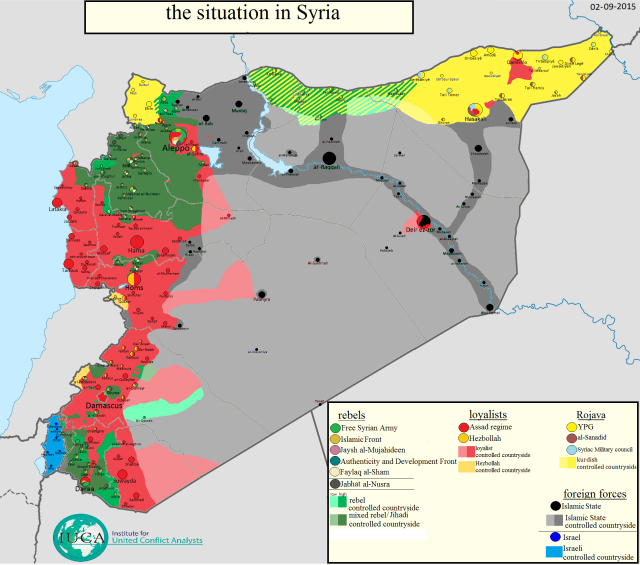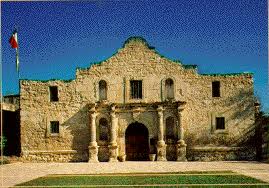
After the downing of the
Russian airliner over Sinai on Oct. 31, Moscow moved into positon to lead the
offensive against the Islamic State in Syria. The Russian air
force transferred a large number of assault helicopters out of its enclave
in Latakia province over to two Syrian air bases east of Homs on the front
lines against ISIS. From the (Tiyas) and
Shayrat Airbases, the Russian command will lead the battle against the Islamic
State over Homs, a city of one million inhabitants and the hub of
central-eastern Syria. As the Russians move over from air strikes to the
offensive against ISIS, they know their combat helicopters are now exposed to being
shot down.
Homs came under direct threat on Nov. 1, when Islamic State forces captured the village of Mahin south of the city, cutting down the Iranian Revolutionary Guards, Syrian army and Hizbollah forces standing in their path and inflicting heavy casualties. Control of Mahin opened the way for ISIS and Syrian rebels to reach the southern suburbs of Homs and seize control of the strategic M5 Highway linking the city to Damascus.
Homs came under direct threat on Nov. 1, when Islamic State forces captured the village of Mahin south of the city, cutting down the Iranian Revolutionary Guards, Syrian army and Hizbollah forces standing in their path and inflicting heavy casualties. Control of Mahin opened the way for ISIS and Syrian rebels to reach the southern suburbs of Homs and seize control of the strategic M5 Highway linking the city to Damascus.

Another group of Russian combat helicopters is now deployed at Hama Military Airport to block off the offensive ISIS and the Nusra Front are preparing to launch in the northern Idlib Province. There too jihadist forces have made advances. On Nov. 5, they snatched from the Syrian army the strategic town of Murek (see map above, look for a Syrian tank battalion on rte. 5) which commands the routes from the north to central Syria.
According to intelligence reports from southern Russia and the Crimean Peninsula, more Russian combat helicopter units are under orders to stand ready for transfer to Syria. Moscow is evidently preparing to take over from the Iranians, the Syrians and Hizballah the heavy-lifting of the war to stop further ISIS advances. More helicopters are needed to support this offensive if it is to go forward on all fronts.
My intelligence sources report Russian “volunteer” units getting organized for departure to Syria from southern Russia and eastern Ukraine, detached from fighting alongside pro-Moscow separatists.
Their arrival in Syria would deepen Russia’s military intervention in the Syrian conflict and also mark its first participation in ground combat, contradicting President Vladimir Putin’s earlier pledge against putting Russian boots on the ground in Syria.
While intensifying the war
on ISIS, the Kremlin is also pushing forward its plan for a political solution
of the Syrian crisis, to be discussed at the forthcoming multinational
conference in Vienna.
Tuesday, Nov. 10, a number of Western media claimed to “reveal” some of its key points of Russia’s Syrian Peace Plan:
Tuesday, Nov. 10, a number of Western media claimed to “reveal” some of its key points of Russia’s Syrian Peace Plan:
1. Russia and Washington
will draw up an agreed “target list” of parties standing out against a
political resolution of the conflict. They are to be attacked jointly by US and
allies and Russian forces. The proposal does not go into the nature of a
bilateral mechanism for determining who figures on the “target list.” Moscow
would really prefer the Russian and the US-led coalition air forces not to
confine their attacks to ISIS, but extend them also to Syrian rebel groups.
Russia could then refute US and NATO allegations that only one out of every
nine Russian air strikes is directed against an ISIS target, with the majority
aimed at Syrian rebel groups.
The Obama administration
did not reject a priori the proposed US-Russian air force
collaboration in Syria and Iraq, but requested additional clarifications from
Moscow.
2. Moscow proposes an
immediate cease-fire on all Syrian army-rebel warfronts. The proposal does not
say if it should apply to the foreign forces fighting in the country, such as
the Iranian Revolutionary Guard Corps, Hizballah, the pro-Iranian militias and
the Russians themselves.
3. Once the cease-fire
goes into effect, all the parties and organizations involved in the war will be
convened for a national dialogue. This round-table conference will have three
main goals:
A. Release of all
prisoners and hostages held by the various sides.
B. Preparation of
parliamentary and presidential elections with a general amnesty for political
prisoners.
C. Establishment of a new
government committed to implementing agreed constitutional reforms that center
on the transfer of presidential powers from Assad to the designated prime
minister.
In other words, Assad will
not be made to step down as president at once, but will have to give up his
presidential powers, including control of the military and intelligence
services.
It is assumed that Putin
put this clause before the Syrian ruler in Moscow as a diktat he had no choice
but to accept.
4. The Russian president
offers a personal guarantee that Assad will not be permitted to run for
president in the coming elections, but he has accepted the Syrian ruler’s
proviso that members of his family and ruling caste will be eligible for
election.
5. All the rebel groups
and militias that take part in implementing the Russian plan will be absorbed
into Syria’s military or other security services and place themselves under
their orders.
6. Governments and other bodies outside Syria will
undertake to halt weapons supplies to all combatant forces. This provision
applies not only to the US and Saudi Arabia with regard to rebel groups, but
also to Russia and Iran as sponsors of the Syrian army.
7. Russia will continue to maintain
military force in Syria as security for the agreement’s full implementation,
contingent on UN Security Council endorsement of its presence.
There are 80,000 ISIS
fighters, only 30,000 are in Iraq and all the rest are in Syria. The 30,000 foreigners who have joined the terrorist
organization include 7,000
citizens of former Soviet states as well as citizens from Western European
countries, North America and Australia. Yevgeny Sysoyev, deputy head of
the FSB, Russia's internal security service, said ISIS is estimated to be in control of 40 percent of Iraq
and 50 percent of Syria.
Israel's Supreme Court, pictured above, on Thursday turned down an appeal
against the destruction of the homes of terrorists who murdered Israelis,
saying eight of the nine homes in question could be destroyed. The homes belong
to the families of the terrorists who murdered Na'ama and Eitan Vaknin, Malachi
Rozenfeld and Danny Gonen. The court ruled that the house of one of the
terrorists who murdered Rozenfeld should not be destroyed because of the weak
link between the terrorist and the other residents of the building. The judges
criticized the state over its long delays in carrying out the orders for
destruction of the houses, compared to the very short amount of time that the
court was given because of Prime Minister Netanyahu's push for a quick verdict.
About 7,500 Kurdish Peshmerga fighters, backed by US air
power, launched an attack on the Iraqi city of Sinjar on Thursday morning an effort to retake the
city, located close to the Syrian border, from ISIS. The ground assault is
being carried out by two Kurdish groups and the Yazidi militia. A previous
attack on Sinjar in December 2014 failed. Besides the goal of
retaking all of Mt. Sinjar and the city, which lies in ruin, the main goal of
the attack is control of
Route 47 that connects the northern Iraqi city of Tal Afar with the northern
Syrian city of Raqqa. Raqqa is the ISIS capitol. If the Kurds succeed in
taking control of a part of the route they will be able to sever the link between the two
ISIS capitals, Raqqa and the Iraqi city of Mosul, and prevent the terrorist
organization from sending forces from Syria to Iraq and vice versa.
If the Kurds succeed in cutting off the route it will be the most serious blow
suffered by ISIS this year. The campaign may last months since winter has
already begun in northern Iraq and Syria, and it is only a matter of time until
the entire area in both countries is covered with snow that will apparently
halt the Kurdish attack until sometime in spring 2016.
Despite the US air support, it seems unlikely that the Peshmerga will be able to achieve a quick victory.
On another front in Iraq, the Peshmerga, also with US air support, have been trying for nearly six months to uproot ISIS from its positions around the strategic oil refining city of Kirkuk, but without success.
Despite the US air support, it seems unlikely that the Peshmerga will be able to achieve a quick victory.
On another front in Iraq, the Peshmerga, also with US air support, have been trying for nearly six months to uproot ISIS from its positions around the strategic oil refining city of Kirkuk, but without success.
Russian President Vladimir Putin said Wednesday that the
program for modernizing his country's military does not mean that Moscow is
gearing up for an arms race. At a Russian defense industry conference in the
capital, he said the industry is being compensated for years of neglect
following the end of Soviet Union. He also said Russia should aspire to
manufacture all of its military systems independently and not be dependent on
imports and foreign arms manufacturers.


No comments:
Post a Comment